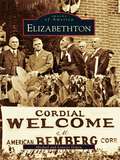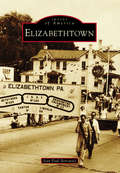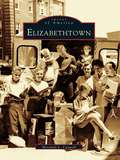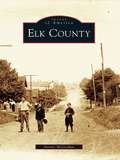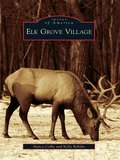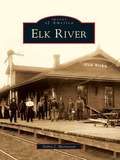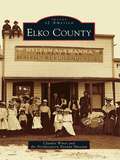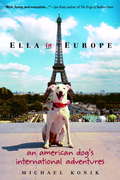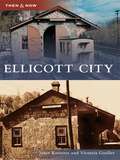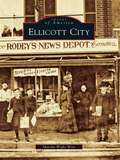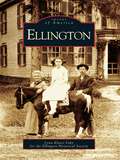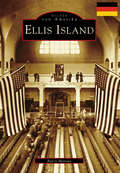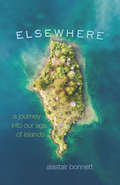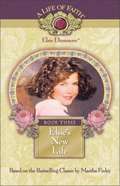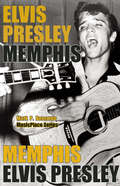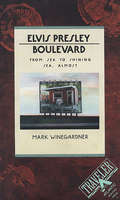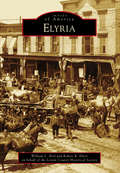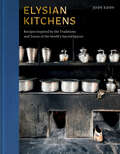- Table View
- List View
Elizabethton
by Michael Depew Lanette DepewThe bustling city of Elizabethton, Tennessee, located on the convergence of the Watauga and Doe Rivers, is the product of a long and rich history. For centuries its fertile ground and ample wildlife sustained the Cherokee Indians, who later leased and sold a vast amount of land to settlers in the mid-1700s. In 1772 these settlers formed the Watauga Association, becoming what Teddy Roosevelt called the first "men of American birth to establish a free and independent community on the continent." The era of industrialization resulted in severalfactories and mills all along Elizabethton's rivers, creating a commercial paradise that continues to thrive today.
Elizabethtown
by Jean-Paul BenowitzSettled in 1708 and incorporated as a borough in 1827, Elizabethtown, Pennsylvania, is located five miles from the Susquehanna River in Lancaster County, 20 miles from both the county seat Lancaster City, to the east, and Harrisburg, the state capital, to the west. With its Old Peter's Road, Elizabethtown played an important role in the westward expansion of the nation during the 18th and 19th centuries. Construction on the first railroad began in 1834, and Elizabethtown remains a strategic stop on the Amtrak Keystone line between Harrisburg and Philadelphia. Along with its proximity to Hershey, Pennsylvania, Elizabethtown has been home to a Mars, Inc., confectionery plant since 1970 (formerly Klein's Chocolate Company, incorporated in 1914). Elizabethtown College was founded in 1899, and the Masonic Village followed in 1910. The Pennsylvania State Hospital for Crippled Children opened in 1929, later becoming the Pennsylvania Department of Corrections Training Academy in 1991.
Elizabethtown (Images of America)
by Meranda L. CaswellIn the 1850s, Elizabethtown flourished due to the traffic from the Louisville & Nashville Railroad and Turnpike. Over the next decades, the community grew in size and population, evolving into the romantic travel destination and quaint hometown that it is now. Today, visitors tour Elizabethtown to immerse themselves in historical significance: the Schmidt's Museum of Coca-Cola Memorabilia, President Abraham Lincoln's heritage, Gen. George Armstrong Custer's stay before his last stand, Gen. John Hunt Morgan's raids during the Civil War, and Philip Arnold's western adventures. The Brown-Pusey House, built around 1825, is open to the public. Couples continue to marry in this historic boarding house and its formal garden.
Elk County
by Dennis McgeehanElk County, located in the scenic Allegheny Mountains of north-central Pennsylvania, is named and known for the wild, free-roaming elk herd that has become a valuable source of tourism. Sportsmen are attracted to this hunting and fishing paradise, which includes the Allegheny National Forest and the headwaters of the Susquehanna River system. Camping and canoeing entice visitors to the natural beauty of this wilderness setting. Elk County is a worldleader in the fields of carbon and powdered metallurgy. A modern paper mill enriches the local economy, and thousands of people each year visit the Chainsaw Carvers Rendezvous, which is part of theLumber Heritage Region of Pennsylvania. The historic photographs featured in Elk County illustrate the industry, character, and faith of the county's residents from pioneer spirit to present progress through the wealth of its vibrant and enduring communities.
Elk Grove
by Elizabeth PinkersonElk Grove's roots go back to 1850, when the community consisted of only a stage-stop hotel. In 1876, this small farm town in the shadow of Sacramento became a crossroads along the new railroad tracks. As the railroad era progressed, it brought significant changes to Elk Grove--fields were transformed into orchards, vineyards, and eventually, residential developments. But Elk Grove remained just a part of southern Sacramento County until citizens prevailed in their attempt to establish cityhood. The city was formally incorporated on July 1, 2000, with 72,665 residents and, by 2006, had grown remarkably to exceed 130,874.
Elk Grove Village (Images of America)
by Kelly Behnke Nancy ColbyPrior to 1956, the area now known as Elk Grove Village was a massive cornfield. On July 17, 1956, Elk Grove Village was incorporated as a village, with a population of 116. Since that time, the growth of the village can only be described as phenomenal. Over 50 years, the village has dramatically changed since those early days of cornfields. The name Elk Grove Village was adopted from the great number of elk that roamed through the fenced-in portion of Busse Woods, along Arlington Heights Road, south of the Northwest Tollway. American Indians called the region Wapiti, meaning "elk."
Elk River
by Debra J. MortensenFur trade posts were established along the Upper Mississippi River between St. Anthony and St. Cloud during the first part of the 19th century. One of these trading posts was established by Pierre Bottineau on the bluffs just north of the mouth of the Elk River between Orono (upper town) and Elk River (lower town) in 1850. As the fur trade slowed, the logging industry took over and numerous sawmills sprung up along the rivers. Ard Godfrey, well known in the milling industry, established the first mill in Orono in 1851. As the township of Elk River grew, the population jumped from 7 people in 1849 to 134 in 1857. Ponds and gullies were drained and filled to make room for more businesses. In Elk River, learn about the Civil War soldiers, the dynamiting of the Blind Pig Saloon, the murder of Deputy Sheriff Ed Foley, devastating fires, and the Boxcar Murder, told through pictures and newspaper clippings.
Elkhart Indiana
by Amy Lant WengerSome 200 years ago, when the Potawatomi Indians were still among the region's primary inhabitants, there was a winding river that was christened "Coeur de Cerf"-the heart of a stag. Legend has it that the earliest settlers were captivated by a small island that resembled an elk's heart. By 1832, Havilah Beardsley began to lay the foundation for what would soon be known as the village of Elkhart. The little island which inspired the Elkhart name would later be called "Island Park." There were only a few dozen lots in that first plat, but by 1858, Elkhart was incorporated as a growing and bustling new city. Today, Elkhart is recognized as being one of northern Indiana's most enterprising communities, as well as one of the most culturally diverse. Throughout its long and illustrious history, Elkhart has been blessed with a celebration of successes, in fields ranging from musical instruments to pharmaceuticals to recreational vehicles. The images in this book offer a glimpse into the events that helped shape Elkhart into the marvelous city it has become, truly, the "city with a heart" in both name and spirit.
Elko County
by Northeastern Nevada Museum Claudia WinesElko County, located in the northeast corner of Nevada, is the fourth largest county in the continental United States. Miles and miles of sagebrush give way to scenic spots, such as Lamoille Canyon and the Ruby Mountains, and locals are proud of this ruggedly beautiful land. Although the county's area is vast, there are only 2.5 people per square mile, and almost 90 percent of the land is owned by the federal government. The major towns in Elko County were established in the late 1860s, when the railroad arrived and brought ranching and mining jobs to the area. In the 1930s, Elko County began attracting big-name entertainment and also became a destination for gaming, and those traditions continue today. With its rich heritage and unique, high-desert landscapes, Elko County is considered one of the last frontiers of the Old West.
Ella in Europe: An American Dog's International Adventures
by Michael KonikPart travelogue, part valentine to a beloved pet, "Ella in Europe" chronicles Konik's magical six-week journey through Europe with his dog, Ella.
Ellen Outside the Lines
by A. J. SassWinner of a Sydney Taylor Book Award Honor! A heartfelt novel about a neurodivergent thirteen-year-old navigating changing friendships, a school trip, and expanding horizons for fans of Rain Reign and Ivy Aberdeen's Letter to the World. Thirteen-year-old Ellen Katz feels most comfortable when her life is well planned out and people fit neatly into her predefined categories. She attends temple with Abba and Mom every Friday and Saturday. Ellen only gets crushes on girls, never boys, and she knows she can always rely on her best-and-only friend, Laurel, to help navigate social situations at their private Georgia middle school. Laurel has always made Ellen feel like being autistic is no big deal. But lately, Laurel has started making more friends, and cancelling more weekend plans with Ellen than she keeps. A school trip to Barcelona seems like the perfect place for Ellen to get their friendship back on track. Except it doesn't. Toss in a new nonbinary classmate whose identity has Ellen questioning her very binary way of seeing the world, homesickness, a scavenger hunt-style team project that takes the students through Barcelona to learn about Spanish culture and this trip is anything but what Ellen planned. Making new friends and letting go of old ones is never easy, but Ellen might just find a comfortable new place for herself if she can learn to embrace the fact that life doesn't always stick to a planned itinerary.
Ellicott City: Tales From The Patapsco River Valley (Then and Now)
by Victoria Goeller Janet KustererIn 1772, the Ellicott brothers purchased land and water rights in the valley along the banks of the Patapsco River for $3 an acre. They constructed mills, started the National Road, and brought the railroad to what was then called Ellicott's Mills.
Ellicott City
by Marsha Wight WiseEllicott City, the seat of Howard County, began its life as a mill town before the American Revolution. Quaker brothers Joseph, Andrew, and John Ellicott built their first mill in 1772. The Patapsco Valley and River provided the brothers with the fertile land and power necessary to make the finest wheat flour. Ellicotts Mills, as the town was first known, grew steadily, becoming home to mill workers and merchants. Maryland founding families such as the Carrolls, Dorseys, and Warfields kept their family fortunes in Ellicott City because of the brothers' agricultural expertise. Thus a town rich in history, tradition, and architectural gems was born. Highlighted in Images of America: Ellicott City are many long-gone local landmarks, including the Patapsco Female Institute and Rock Hill and St. Charles Colleges. Featured as well are the monuments to bygone days that have endured time, progress, floods, and fires, and are still standing today.
Ellington
by Ellington Historical Society Lynn Kloter FahyLocated 16 miles northeast of Hartford, Ellington was incorporated in 1786 and has retained the charm of a New England village and farming community. Originally part of Windsor, it was known as the Great Marsh. Ellington Center, with its town green and 18th- to 20th-century houses, is on the National Register of Historic Places. Japanese business pioneer Francis Hall donated the jewel of the district to his hometown in 1903--the neoclassical-revival-style library. Archival photographs preserve faded memories of schools, churches, townspeople, and a unique dentist's tooth-shaped tombstone. Ellington captures a time when John Hall's Ellington School was known worldwide, Crystal Lake was a popular summer resort, and Daniel Hallady invented the modern windmill.
Ellis Island: New Hope in a New Land
by William Jay JacobsAn inspiring chronicle of the immigrant experience recounts the history of Ellis Island from 1892 to 1954, the period during which more than seventeen million immigrants passed through its doors in search of new lives in America.
Ellis Island: Official Ellis Island Souvenir Guide (Images of America)
by Barry MorenoThe United States is considered the world's foremost refuge for foreigners, and no place in the nation symbolizes this better than Ellis Island. Through Ellis Island's halls and corridors more than twelve million immigrants-of nearly every nationality and race-entered the country on their way to new experiences in North America. With an astonishing array of nineteenth- and twentieth-century photographs, Ellis Island leads the reader through the fascinating history of this small island in New York harbor from its pre-immigration days as one of the harbor's oyster islands to its spectacular years as the flagship station of the U.S. Bureau of Immigration to its current incarnation as the National Park Service's largest museum.
Elsewhere: One Woman, One Rucksack, One Lifetime of Travel
by Rosita Boland'Utterly engaging.' - Sunday TimesFrom her first life-changing solo trip to Australia as a young graduate, Rosita Boland was enthralled by travel. In the last thirty years she has visited some of the most remote parts of the globe carrying little more than a battered rucksack and a diary.Documenting nine journeys from nine different moments in her life, Elsewhere reveals how exploring the world – and those we meet along the way – can dramatically shape the course of a person’s life. From death-defying bus journeys through Pakistan to witnessing the majestic icescapes of Antarctica to putting herself back together in Bali, Rosita experiences moments of profound joy and endures deep personal loss.In a series of jaw-dropping, illuminating and sometimes heart-breaking essays, Elsewhere is a book that celebrates the life well-travelled in all its messy and wondrous glory.
Elsewhere: A Journey into Our Age of Islands
by Alastair BonnettThere are millions of islands on our planet. New islands are being built at an unprecedented rate, for tourism and territorial ambition. Many are also disappearing, besieged by rising sea levels. The story of our world’s islands is one of the great dramas of our time, and it is playing out around the planet—islands are sprouting or being submerged everywhere from the South China Sea to the Atlantic. Elsewhere is the story of this strange and mesmerizing planetary spectacle. In this book, explorer and geographer Alastair Bonnett takes us on a thought-provoking tour of the world’s most fascinating islands. He traveled the globe to provide a firsthand look at numerous islands, sketching a vivid likeness of each one he visited. From a “crannog,” an ancient artificial island in a Scottish loch, to the militarized artificial islands China is building; from the disappearing islands that remain the home of native Central Americans to the ritzy new islands of Dubai; from Hong Kong to the Isles of Scilly—all have compelling stories to tell. As we journey around the world with Bonnett, he addresses urgent contemporary issues such as climate change, economic inequality and the changing balance of world power as reflected in the fates of islands. Along the way, we also learn about the many ways islands rise and fall, the long and little-known history of human island building and the prospect that the inland hills and valleys will one day be archipelagos. Featuring Bonnett’s charming hand-drawn maps and 33 full-color photos, Elsewhere is a captivating travel book for any armchair adventurer.
The Elsewhere Community (The CBC Massey Lectures)
by Hugh KennerAcclaimed literary critic Hugh Kenner examines Western culture's insatiable need for stimulation encountered elsewhere - from the eighteenth century's Grand Tour, to the self-imposed exile of modernist writers, to the disembodied global journeys the Internet avails us today. Kenner brings to this fascinating study knowledge of a wide array of disciplines. Hugh Kenner has written on topics ranging from geodesic domes to Bugs Bunny, but is perhaps best known for The Pound Era, his definitive study of Ezra Pound's life and work.
Elsie's New Life
by Martha FinleyAs Elsie grows up, her life is full of change. Old friendships are renewed. New ones bring new dilemmas - an unexpected proposal - to whom will Elsie turn when she is put to first test of love?
Elvis Presley
by Mark P BernardoWeaving the story of the King's personal and public life with detailed descriptions of the locations in Memphis that served as the setting for his musical education and evolution, this pop culture guide offers a refreshingly even-handed account of Elvis Presley's life. Elvis came to Memphis as a 13-year-old boy, and within a few years, he was shocking and seducing the world with a mixture of moves and sounds he had first seen and heard in the city's streets, churches, and bars. This comprehensive tour of places on which Elvis left his mark includes the Peabody Hotel, where he had his senior prom; Ellis Auditorium, where he played his first show; the Sun Studio, where he recorded his first singles; Lansky Brothers Clothiers, where he bought his suits; and Graceland, where he lived with his wife Priscilla and died in 1977. Anecdotes about each of the locations and how they shaped Elvis's personal and musical identity enhance the travel information, while street maps and a handy size make this book an invaluable companion to Memphis visitors and lovers of rock and roll.
Elvis Presley Boulevard: From Sea to Shining Sea, Almost (Traveler Ser.)
by Mark WinegardnerElvis Presley Boulevard chronicles the trip we’ve all taken-or wanted to take-into the country that confounds its admirers and delights even its critics. Mark Winegardner, a young Ohioan, spent the formative summers of his wonder years touring the States with his family in a succession of recreational vehicles. Much later, only months before his wedding, he undertakes another transcontinental odyssey, this time without benefit of license-plate games with his sister or parental warnings to get his feet out of the car window.He arms himself with only the bare essentials: a Styrofoam cooler; a Hawaiian shirt; enough cash for gas, blue plate specials, and the occasional knickknack; a buddy; and the buddy’s ailing '68 Chevy Impala. Determined to extract full value from every scenic overlook, these two set out to discover America. They visit Xanadu, Foam House of Tomorrow, in Gatlinburg, Tennessee; the Woody the Woodpecker Museum in Los Angeles; and Truth or Consequences, New Mexico, the only community named after a game show. They play the Easter Island Hole at Magic Carpet Golf in Tucson. They marvel at the fourteen peacocks strolling Graceland’s lawn and at the vastness of the prairie states, "where no one speaks French or pays to park.” They collect 3-D glasses. They eat Devil Dogs. They take the amazing Miracle Photo. They discover themselves. Most amazing of a11, they discover an unbroken chain of Elvis tapestries, Elvis ashtrays, Elvis T-shirt wearers, and Elvis imitators that unites this land as surely as Route 66 divides it.
Elyria
by Robert R. Ebert Lorain County Historical Society William L. BirdElyria is named for Heman Ely, who in 1817 settled in a strategically located area close to Lake Erie along the picturesque Black River. Historically, Elyria, which became the seat of Lorain County, has been a center of commerce and government while also serving as a market and source of supplies for the surrounding agricultural community. Industrial development has included steel mills, quarries, automobile-related firms, and a wide variety of other manufacturing facilities. Over the years, Broad Street has been an important center of retail and professional activity. For recreation, Elyria's citizens are able to enjoy beautiful parks and recreation facilities.
Elysian Kitchens: Recipes Inspired by the Traditions and Tastes of the World's Sacred Spaces
by Jody EddyA lushly photographed cookbook showcasing the intersection of culture, spirituality, and cuisine. Elysian Kitchens bridges diverse beliefs, weaving a modern tapestry of faiths and histories in 100 time-tested recipes. Monasteries, temples, mosques, and synagogues have long been centers of culinary innovation. No mere relics of the past, they reflect our modern world and are as dynamic and fundamental to our society as they ever were. Granted rare access to closely guarded religious sanctuaries, Jody Eddy demonstrates how the monastic culinary philosophy can be adopted by any home cook or professional chef interested in integrating sustainable, time-honored cooking practices into their daily lives. Her 100 recipes include dumplings (momos) inspired by the cooking of monks at Thikse, a Buddhist temple in Ladakh, India, nestled in the Himalayas. From Kylemore Abbey, in Connemara, Ireland, she brings instructions for cooking Lamb Burgers with Creamy Red Cabbage Slaw and Rosemary Aioli as the nuns do, with enough leftover sauce to drizzle over smoked salmon bagels the next day. From a Jewish community in Brooklyn, New York, come time-tested kosher recipes, including Potato Kugel and Matzo Ball Soup. Ginger and Ginkgo Nut Stuffed Cabbage Rolls illustrate Zen Buddhist cooking from Eihei-ji in Japan. In Morocco, she finds a Sufi chicken and olive tajine recipe that makes for a perfect dinner. And for dessert, Panellets (tiny sugar-and-almond cookies), courtesy of an 1100-year-old Spanish monastery. A global story of cooking across communities, Elysian Kitchens contributes to the most important conversations taking place in the food world today by examining a gastronomic heritage that has until now been virtually unexplored. This is a cookbook for anyone eager to discover the traditions of magnificently beautiful, endlessly compelling places that embody the wisdom of the ages and offer the promise of a more optimistic and sustainable future.
The Embalmer: A gripping new thriller from the international bestseller
by Alison BelshamHas the ancient Egyptian cult of immortality resurfaced in Brighton?When a freshly-mummified body is discovered at the Brighton Museum of Natural History, Detective Francis Sullivan is at a loss to identify the desiccated woman. But as Egyptian burial jars of body parts with cryptic messages attached start appearing, he realises he has a serial killer on his hands. Revenge, obsession and an ancient religion form a potent mix, unleashing a wave of terror throughout the city. Caught in a race against time while battling his own demons, Francis must fight to uncover the true identity of the Embalmer before it's too late...
